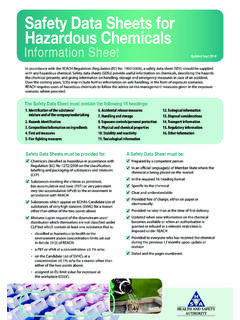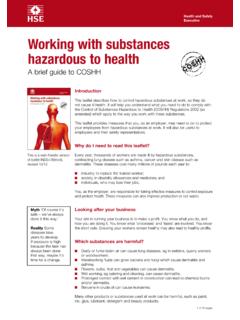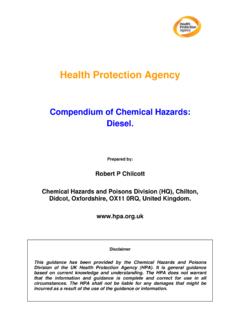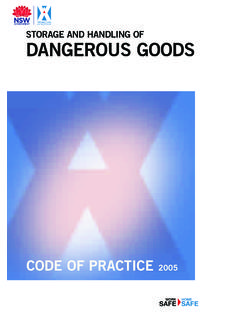Transcription of Material Safety Data Sheet - Dubois Chemicals
1 Material Safety data Sheet Dubois 200. 1. Product and company identification Product name : Dubois 200. Supplier/Manufacturer : Dubois Chemicals , Inc. 3630 E. Kemper Rd. Cincinnati, OH 45241. Phone: 1-800-438-2647. Dubois Chemicals Canada, Inc. 3450 Ridgeway Drive, Unit 2. Mississauga, Ontario, L5L OA2. Phone: 1-866-861-3603. Recommended use : Industrial applications: Corrosion Inhibitor MSDS # : MS0127014. Product code : 01390104, 01390470, 01390330. Validation date : 5/19/2011. Version : 1. In case of emergency : 1-866-923-4919 (US and Canada). 01-651-523-0314 (Int'l and Mexico). Hazardous Material : Health * 2. Information System ( ). 0. Flammability Physical hazards 0. 2. Hazards identification Physical state : Liquid.
2 OSHA/HCS status : This Material is considered hazardous by the OSHA Hazard Communication Standard (29 CFR ). Emergency overview : WARNING! CAUSES EYE IRRITATION. MAY CAUSE ALLERGIC SKIN REACTION. MAY BE. HARMFUL IF SWALLOWED. MAY CAUSE SKIN IRRITATION. CONTAINS Material . THAT MAY CAUSE TARGET ORGAN DAMAGE, BASED ON ANIMAL data . Do not breathe vapor or mist. Do not ingest. Do not get on skin or clothing. Avoid contact with eyes. Wash thoroughly after handling. Routes of entry : Dermal contact. Eye contact. Inhalation. Potential acute health effects Inhalation : Serious effects may be delayed following exposure. Ingestion : Harmful if swallowed. Skin : Moderately irritating to the skin. May cause sensitization by skin contact.
3 Eyes : Irritating to eyes. Potential chronic health effects Chronic effects : Contains Material that may cause target organ damage, based on animal data . Once sensitized, a severe allergic reaction may occur when subsequently exposed to very low levels. Carcinogenicity : No known significant effects or critical hazards. Target organs : Contains Material which may cause damage to the following organs: upper respiratory tract, skin, central nervous system (CNS), eye, lens or cornea. Medical conditions : Pre-existing skin disorders and disorders involving any other target organs mentioned in aggravated by over- this MSDS as being at risk may be aggravated by over-exposure to this product. exposure Validated on 5/19/2011.
4 Dubois 200 1/7. 2. Hazards identification See toxicological information (section 11). 3. Composition/information on ingredients Name CAS number % by weight Ethanolamine 141-43-5 5 - 10. 2,2',2''-Nitrilotriethanol 102-71-6 1-5. 2-aminoethanol, monoester with boric acid 10377-81-8 5 - 10. There are no additional ingredients present which, within the current knowledge of the supplier and in the concentrations applicable, are classified as hazardous to health or the environment and hence require reporting in this section. 4. First aid measures Eye contact : Check for and remove any contact lenses. Immediately flush eyes with plenty of water for at least 15 minutes, occasionally lifting the upper and lower eyelids.
5 Get medical attention immediately. Skin contact : In case of contact, immediately flush skin with plenty of water for at least 15 minutes while removing contaminated clothing and shoes. Wash clothing before reuse. Clean shoes thoroughly before reuse. Get medical attention immediately. Inhalation : Move exposed person to fresh air. If not breathing, if breathing is irregular or if respiratory arrest occurs, provide artificial respiration or oxygen by trained personnel. Loosen tight clothing such as a collar, tie, belt or waistband. Get medical attention immediately. Ingestion : Wash out mouth with water. Do not induce vomiting unless directed to do so by medical personnel. Never give anything by mouth to an unconscious person.
6 Get medical attention immediately. Protection of first-aiders : No action shall be taken involving any personal risk or without suitable training. It may be dangerous to the person providing aid to give mouth-to-mouth resuscitation. Wash contaminated clothing thoroughly with water before removing it, or wear gloves. Notes to physician : In case of inhalation of decomposition products in a fire, symptoms may be delayed. The exposed person may need to be kept under medical surveillance for 48 hours. 5. Fire-fighting measures Flammability of the product : In a fire or if heated, a pressure increase will occur and the container may burst. Extinguishing media Suitable : Use an extinguishing agent suitable for the surrounding fire.
7 Not suitable : None known. Special exposure hazards : Promptly isolate the scene by removing all persons from the vicinity of the incident if there is a fire. No action shall be taken involving any personal risk or without suitable training. Hazardous thermal : Decomposition products may include the following materials: decomposition products carbon dioxide carbon monoxide nitrogen oxides Special protective : Fire-fighters should wear appropriate protective equipment and self-contained breathing equipment for fire-fighters apparatus (SCBA) with a full face-piece operated in positive pressure mode. 6. Accidental release measures Personal precautions : No action shall be taken involving any personal risk or without suitable training.
8 Evacuate surrounding areas. Keep unnecessary and unprotected personnel from entering. Do not touch or walk through spilled Material . Avoid breathing vapor or mist. Provide adequate ventilation. Wear appropriate respirator when ventilation is inadequate. Put on appropriate personal protective equipment (see section 8). Environmental precautions : Avoid dispersal of spilled Material and runoff and contact with soil, waterways, drains and sewers. Inform the relevant authorities if the product has caused environmental pollution (sewers, waterways, soil or air). Methods for cleaning up Validated on 5/19/2011. Dubois 200 2/7. 6. Accidental release measures Small spill : Stop leak if without risk.
9 Move containers from spill area. Dilute with water and mop up if water-soluble. Alternatively, or if water-insoluble, absorb with an inert dry Material and place in an appropriate waste disposal container. Dispose of via a licensed waste disposal contractor. Large spill : Stop leak if without risk. Move containers from spill area. Approach release from upwind. Prevent entry into sewers, water courses, basements or confined areas. Wash spillages into an effluent treatment plant or proceed as follows. Contain and collect spillage with non-combustible, absorbent Material sand, earth, vermiculite or diatomaceous earth and place in container for disposal according to local regulations (see section 13).
10 Dispose of via a licensed waste disposal contractor. Contaminated absorbent Material may pose the same hazard as the spilled product. Note: see section 1 for emergency contact information and section 13 for waste disposal. 7. Handling and storage Handling : Put on appropriate personal protective equipment (see section 8). Eating, drinking and smoking should be prohibited in areas where this Material is handled, stored and processed. Workers should wash hands and face before eating, drinking and smoking. Persons with a history of skin sensitization problems should not be employed in any process in which this product is used. Do not get in eyes or on skin or clothing. Do not ingest. Avoid breathing vapor or mist.





